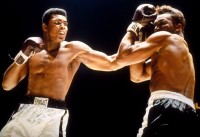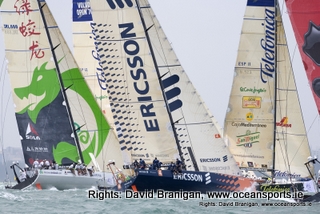
The other night I was watching TV and saw the 2001 movie “Ali” with Will Smith. Automatically my memories went back to the time when I was a kid when I was watching famous world title fights together with my father in the middle of the night. Who cannot remember the names of Mohammed Ali, Joe Frazier, George Foreman, Sugar Ray Leonard and Sonny Liston? Even my little cousin has heard of these super champions. But if you ask someone to name the current heavyweight champion of the world, he will stare at you blankly, ignorance all over his face. I have to admit, I also had to look it up; stay tuned, they are Vitali Klitschko for the WBC, David Haye for the WBA and Wladimir Klitschko for the IBF and WBO. Confused? So am I. What happened to boxing and will old times ever revive again?
Boxing used to be a sport with a high fan base. Boxing was loved as it was a good simulation of a real man to man fight and as mankind always will fight and likes to watch violence, it appealed to many and hence boxing has experienced several golden periods like the twenties and the sixties and seventies. The sport has been cyclical to some extent and some claim there will arrive a new golden age sometime in the future. This could well be true but not without the necessary action. Not only has the sport of professional boxing changed, the environment has changed even more and this makes it an entirely different ballgame this time around, where just sit and wait for the next hay day probably won’t work.
Let us analyze briefly what the current problems in professional boxing are:
1.Media coverage. The big boxing fights are not broadcasted on the public networks. The boxing community seems to totally rely on pay per view. This is expensive and can run up to as much as USD 50.0. So a sport intended for the masses has eroded into one that is available almost exclusively to the upper class. This just doesn’t make sense. If boxing indeed aims to be a popular sport again with the sports fan, one that can compete with other sports, boxing should be seen on cable again. As far as the other media are concerned, there is little coverage on boxing (sports magazines only pay little attention etc)
2. Confused mindset of the consumer. Apart from the diehard fans, it is difficult for the average consumer to comprehend the boxing scene. Firstly there are 4 different unions (WBC, WBA, IBF and WBO) and the vast majority doesn’t have a clue, which union is most important and hence who is the true undisputed champion of the world. Moreover, again apart from the diehard fan, for the uneducated viewer, it is difficult to comprehend the points system as boxing is a jury sport.
3. Bad image of the sport. Boxing hasn’t the best of reputations amongst sports. It is often associated with the criminal scene, whereas there is the public perception that fights are often fixed. Promoters like Don King have aided to this perception. Promoters often decide when a boxer will fight, against whom he fights, where he fights and against what fee he fights. Moreover, promoters often protect their champions and hence purse by letting them fight with much lower ranked opponents instead of the strongest challengers. For example for a long time Mike Tyson only fought low ranked opponents. This obviously does not help the image of the sport. Spectators want to see the strongest boxers in the ring.
4. Overcrowded sports market. Clearly the world has changed. Boxing in its hay days in the seventies enjoyed much less competition from other sports. Not only were baseball and football seasons much shorter, at the time there were few other sports, which enjoyed the same popularity. With the advance of TV, other major sports expanding and several new sports emerging (amongst them other fighting sports such as MMA), boxing has not taken the right steps to remain competitive and sufficiently attractive.
5. No charismatic stars means no connectivity. The sport of boxing is lacking any stars at the moment, where fans can connect with; stars are either being loved (the good guy) or hated (the bad guy) but in both cases there is connectivity. If a sport has stars it sells itself. If the sport would have personalities like Mohammed Ali or Sugar Ray Leonard, it would be much easier to grab a piece of the pie.
The conclusion should be that boxing has positioned itself in a very difficult position and action should be taken if it wants to regain some of the ground it has lost. The sport is not entirely knock out; it still has some popularity (particularly in the US and some parts of Europe) and if the right buttons are pushed, it can fight its way up again. MMA (Mixed Martial Arts) has proven it can be done, so no reason why boxing could not regain. In fact both sports could easily co-exist and learn from one another. For example boxing events could learn a lot from the production and marketing of MMA events, which attract a much younger crowd. So what would be the major solutions for boxing?
1. Give boxing back to the people: Pay Per View is too expensive to attract a big television crowd. Either PPV prices should be cut and a volume policy should be chosen or even better PPV should be entirely eliminated. In any case fights should become available again to larger audiences, which in turn would make it increasingly attractive to sponsors again. This way boxing would no longer be exclusively available to a small upperclass only. Obviously one could think of combinations between PPV and the channel networks in order to generate most revenues.
2. Clarify and regulate the sport: as explained, the mindset of the average boxing fan needs to be clear. In this perspective the sports should be better regulated. For example the points system may be changed, which might lead to more spectacular fights, which could be more competitive with for example MMA. Additionally it would help to have one undisputed champion of the world (the current titles have become somewhat meaningless); so unions should sit together and either merge or find ways to accomplish such clarity. Finally, the best fighters should regularly fight each other instead of worldchampions exclusively fighting minor fighters in order to keep their belts
3. Change the image of the sport: as boxing hasn’t the best reputation amongst sports, it should try to improve. It means the role of the promoter may have to be looked at and regulators and boxers themselves should take up their responsibility.
4. Reposition the sport: boxing may need a refreshment. Other fighting sports have proven that active marketing increases the connectivity. Boxing may need an overhaul and review its mission and values, particularly as it plays an important role in less privileged local communities, where values do not always play a role. The sport could take up its responsibility. Additionally boxing has a couple of advantages. First of all it is Olympic, which the sport can build from. By increasing the visibility of amateur boxing and emphasizing the values, the sports may attract larger audiences again. Secondly recreational boxing is becoming very popular in the gyms. This means the interest in the sports is still very much present. Proper marketing may unlock this potential. The conclusion is that rather than starting at the top (professional boxing), it may pay off to start at the bottom. And if stars re-appear (and they will), they could be role models for the sport again.
I am far from an expert and more importantly I am not a boxer (apart from hitting a few in the gym during my university time). I am aware some of these changes may be rather difficult to implement. However I have noticed other fighting sports have been able to do this, whilst simultaneously boxing has lost some of its appetite. I am a believer the sport should be managed and regulated by sportspeople themselves, they know best. So action required!


 One of golf’s most famous and celebrated holes in the world, the 17th St Andrews hole, the Road Hole, will be lengthened by 35 yards, to 490 yards. Work will begin this week and a new tee will be built on a driving range nearby.
One of golf’s most famous and celebrated holes in the world, the 17th St Andrews hole, the Road Hole, will be lengthened by 35 yards, to 490 yards. Work will begin this week and a new tee will be built on a driving range nearby.